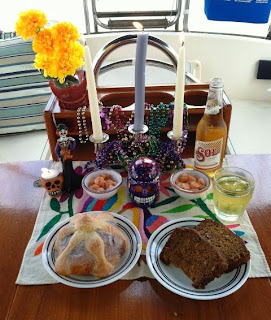It does happen occasionally even in paradise: the universe
conspires against you. So being
oblivious to their fate, a family left the anchorage on a sunny, blustery day
for a delightful sail and by the time they realized that some
crucial equipment was malfunctioning and that the stars were not aligned for
them, they and their boat, Flying Dragon,
were hard aground on the beach.

Ken and I, along with others, responded to the call for
assistance Monday evening. We worked our
dingy by moonlight and flashlight handling lines between the tug and the
grounded vessel. We tested our engine’s
capacity as we carried the heavy lines toward the vessel and then had to back
out of the surf zone to avoid flipping.
We would tie the lines and then move out of range in case they snapped. Our handheld radios crackled with
instructions. Patience
and stamina were tried and optimism tested as lines broke throughout the night as
the tug tried unsuccessfully to pull the 80,000 pound vessel off of the
beach. The tide steadily increased until
1:30 a.m. when it began to subside and the rescue was called off for the
night. It was determined that attempts
would be made again at the next high tide on Tuesday at 5:00 p.m. so we motored back into the dark, quiet
marina wet, tired, and disappointed.
We walked out to the beach in the morning, were hoisted
aboard Flying Dragon and began
packing up EVERYTHING and off- loading it onto the beach. The refrigerator, washing machine, batteries,
the rocks and lead used for ballast, clothing, dishes, tables, dressers, pictures, lamps, books,
linens, everything that had created a comfortable life afloat was piled on the
beach. Within a couple of hours, what
had once been a home became a shell holding nothing but sweet memories.
A welder arrived and cut off the 5-foot rudder that was
preventing the boat from pivoting. An
excavator arrived and dug around the rudder, hoisting it away from the
boat. It then removed the sand around
the perimeter of the vessel.
Pumps and generators were
donated.
A large, heavy sailboat arrived with a strong windlass that was used to
pull on the huge lines. A Nordhaven
arrived and was used as a tug boat.
Lines were cleated to its stern.
Cruisers and vacationers grabbed onto the lines and began pulling in
unison while others pushed on the bow and the Nordhaven pulled to turn Flying Dragon into the sea.
It was 5:00 p.m. on the high tide when she
turned to the west, was pulled past the surf line to cheers, whistles and
clapping and towed to a nearby marina.
It was an amazing confirmation of the fundamental goodness
of humankind and the strength of community.
Boats, lines, muscle power, food, beverages, radios and many other
resources were donated without hesitation.
Strangers worked long hours side by side to help others in need.
There is no denying that the family’s financial and
emotional losses. Flying Dragon has an interesting and
checkered past and the current owners worked tirelessly those days to save her. They carried themselves with extraordinary
grace under extreme pressure and the cruising community was there with them to
help carry the load.





















































